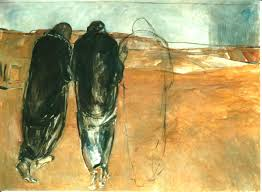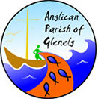preached by Ven Andrew Mintern via Facebook for the Anglican Parish of Glenelg – Sunday 5th April to Sunday 26th April 2020

Palm Sunday
Entering Holy Week
Focus reading Matthew 21:1-11
Introduction
The Word “Hosanna” means save us – it is a plea for help. Today on Palm Sunday we recall this cry of the crowds as Jesus entered Jerusalem, but it is a prayer that we can pray anytime. It is certainly an appropriate prayer not just for holy week but also through the rest of the year as we face this current health crisis.
Holy Week is a Spiritual Journey
Palm Sunday marks the start of our journey through Holy Week. Every year we do that as a community through a number of different events. Normally tonight we would have a Children’s Passover meal and on Maundy Thursday we would have one for the adults followed by the footwashing ceremony, stripping of the church and a prayer vigil. On Good Friday we would read the passion, pray before the cross, and have a children’s stations of the cross service. On Easter morning we would greet the dawn on the Glenelg foreshore with our ecumenical sisters and brothers and then celebrate the resurrection in our Sunday worship lighting our new Paschal candle for the first time in a new Easter season.
Sadly due to coronavirus restrictions we cannot physically walk that journey together this year. We cannot gather to mark these important points on the Journey of Christ to the cross and the empty tomb. We can however still make that journey spiritually. Today I have blessed the palm crosses. We hope to get those to you this week as a sign of this journey and a point of connection to the palms in this church from which the crosses were made. You might use these crosses on Friday when you tune in to Facebook for one of our Good Friday services.
Reflecting on our restrictions
There have been many Christians through history, as there are even now around the world, who have been prevented from worshipping together for a whole range of reasons. This could be because of quarantine, perhaps because of fear of persecution, or incarceration, or because of illness or another reason. If we could gather we would, and we give thanks for the freedom of this country which usually allows us to do so freely. This Holy Week we cannot gather, but we are joined in Spirit. We are joined in God’s love and more than ever we need in our lives the saving power of the cross and Christ’s resurrection. More than ever we can pray ‘Hosanna” Lord save us.
We may not be side by side physically but I invite you to join with me to journey through Holy Week together, into the shadow of the cross which darkens our world and beyond into the hope-filled dawn of new life.
And now, as I finish every Palm Sunday sermon, to be continued…
+ + +
Good Friday
Good Friday
A Reflection on Lament
Focus readings Psalm 22 & Matthew 27:33-61
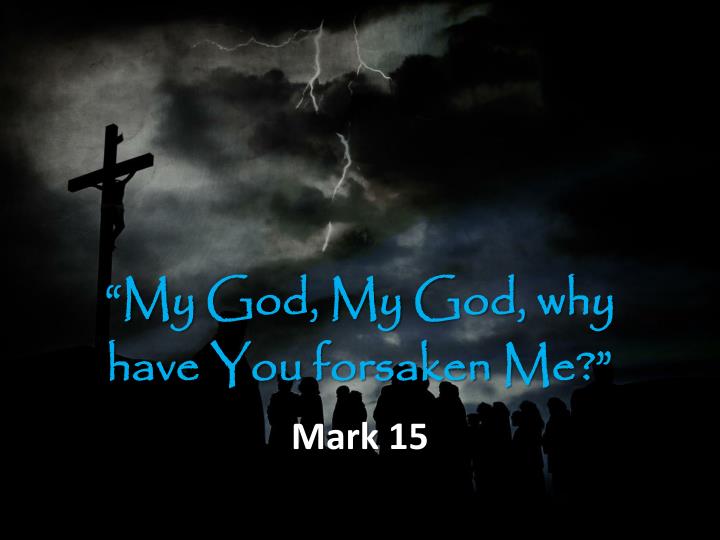
Introducing Lament
We are calling this Good Friday worship a service of Lament before the cross. Both Mark’s Gospel and The Gospel of Matthew record that when Jesus is on the cross, he cried out “Eli, Eli, lema sabachthani”, My God My God why have you forsaken me. These desperate words are from Psalm 22. Some writers have reflected that if Jesus was dying on the cross he wouldn’t have bothered to quote scripture. I disagree. As a faithful Jewish man, this prayer of lament from the scriptures would have come readily to his lips as it should to ours in time of difficulty. The laments in the bible are there for us to express in the times we need it, they should be second nature in our prayer life.
Praying Psalm 22
Psalm 22 is a really powerful psalm – it is filled with the question why?
Why God have you forsaken me?
Why are you so far from my groaning?
Why do you give me no answer?
A prayer like this is not a loss of faith, it is the faithful expression of lament. Importantly this psalm also has expressions of trust in it too
“I will tell of your name to my brothers and sisters,
in the midst of the congregation I will praise you.”
Jesus on the cross teaches us something very important – in the midst of suffering, any suffering, in the midst of our suffering, we can reach honestly into the resources of lament to express how we are feeling. We can hurl prayers of lament at God. We can hurl them at the cross, and demand God’s help. We do this whilst still trusting and affirming that God is with us, even when we feel abandoned, even when, like the psalmist graphically says:
“I am poured out like water,
and all my bones are out of joint.
My heart is like wax;
it is melted within my breast.
My mouth is dried up like a potsherd,
and my tongue sticks to my jaws;
you lay me in the dust of death.”
This is brutally honest prayer. This is the prayer of lament. It is the prayer of the cross.
Offering our prayers of lament
I think today we can do no better than to offer our prayers of lament to God – to put them on the cross. You might like to think about what you lament for today. Perhaps your prayers will be about coronavirus and the suffering of our world, or perhaps it is a lament about isolation and loneliness, or about some other cause of pain in your life.
All our prayers of lament can find their place on the cross, for that is the place where ultimately our prayers, our yearnings and our faithful trusting will meet with God’s power of new life and resurrection which we will celebrate on Easter day.
+ + +
Easter Day
Focus Reading Matthew 28:1-10
Introductory questions
Where do we see the power of Christ’s resurrection
in our world and in our lives?
Where do we long to see the power of Christ’s resurrection
in our world and in our lives?
The Disciples’ experience of Resurrection
The two Mary’s did not expect to find the tomb empty or to be greeted with the message of the angels – they did not expect to meet the risen Christ; nor did Peter and John or Cleopas and the other disciple on the road to Emmaus; nor did the whole twelve, especially Thomas with his doubts. Certainly Paul with his murderous threats, heading to Damascus, did not expect to meet the risen Christ.
The power of resurrection transformed Jesus’ followers and continues to bring hope to Christians around the world.
For Resurrection brings hope to those who are experiencing the fear and pain of illness and suffering, that God’s goodness is stronger than evil.
Resurrection brings hope to those who are experiencing prejudice and oppression that love is stronger than hate.
Resurrection brings hope to those who cannot see a way forward that light is stronger than darkness.
And it brings Hope to those who are grieving or facing their mortality that Life is stronger than death
I see the power of resurrection in the strength of our church community. Continuing to pray and connect together in faith even when we cannot meet.
I see the power of resurrection in the inspirational kindness that people are showing to each other.
I see the power of resurrection in the great acts of service and love being shown by medical professionals and emergency services workers.
I see the power of resurrection in the lives of people who have every reason to give up and yet show a resilience and a spark of life that spreads to others.
I see the power of resurrection in those times of deep deep sadness and grief, when joy comes unexpectedly like a gift.
Risen Christ,
this Easter surprise us again.
Surprise our world with
the power of your resurrection,
for Goodness is stronger than evil,
love is stronger than hate,
light is stronger than darkness
and life is stronger than death. Amen.
+ + +
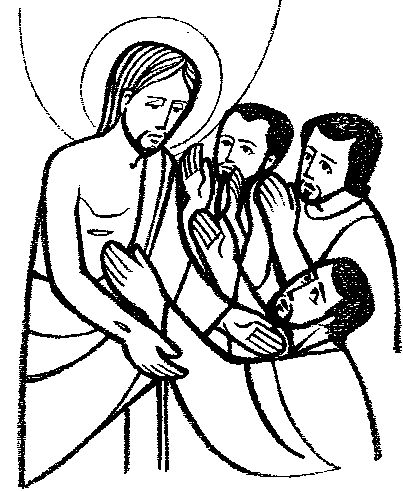
The Second Sunday of Easter
Theme: Trust and Rejoice
Focus reading John 20:19-31
Introduction
“the doors of the house where the disciples had met were locked for fear…” Fear is a powerful emotion. It can cripple us. There is a lot of fear at present. Perhaps our fears are shifting, maybe from ‘I might get sick’ to now thinking ‘how long is this going to go on? What will the world be like when it’s over?’.
The Disciples’ Fear
The disciples were no doubt swimming in fears: they wondered ‘will the same thing happen to us as happened to Jesus’ and ‘what on earth do we do now that Jesus is not with us.’
Fear puts up barriers around us. Our fears try to keep the danger at bay but they also lock us up and keep us trapped. In the Gospel reading twice Jesus comes to be with disciples despite the doors being locked or closed. These barriers are as nothing to the risen Christ.
Despite the fears of the disciples, despite the locked doors and even despite Thomas’ doubts, Jesus appears. He is with them in the midst of their fears and he says simply “Peace be with you.”
Being Sent
Then Jesus breathed onto them the gift of the Holy Spirit and he sends them. He sends them beyond their fears. This is John’s Gospel, not Luke and Acts. In John’s Gospel the gift of the Spirit happens here on Easter Day, rather than at Pentecost (That’s interesting isn’t it?) The gift of the Spirit is part and parcel of accepting the reality of resurrection!
Here is the power of resurrection – It breaks into the disciples’ fears, their hopelessness, their doubts and breathes peace and power into them to move beyond the fears that trap them.
Resurrection for us
This is also the power of resurrection for us, especially this year when we are locked behind doors and are touched with fear. Jesus says to us: ‘peace be with you’. Jesus breathes Spirit into us and sends us.
Where? Where are we being sent? But we can’t go anywhere!
Maybe not physically into the world, but we are being sent into living creatively, hopefully, prayerfully and constructively in this time of coronavirus. We are being sent into making a difference in our world.
We are being sent to spread hope. How? Through our work (if we’re still working), through our relationships, through our care for others.
Being human, we all fear, we all have doubts. But we can trust that the risen Christ is with us, in the midst of them. That is joyful good news. That is transformative. And so we trust and rejoice.
+ + +
The Third Sunday of Easter
The Road to Emmaus
Focus reading – Luke 24:13-35
Introduction
Some of you can already predict that if we are having the road to Emmaus Gospel reading that I will show you my favourite painting by Caravaggio, the Road to Emmaus. And you’d be right! It’s too hard to resist. So here it is appearing on your screen. I am still blown away that I got to see the original in the national gallery in London in 2018. For me it was a spiritual experience. But more than that it was an experience of communion. I’ll explain why.
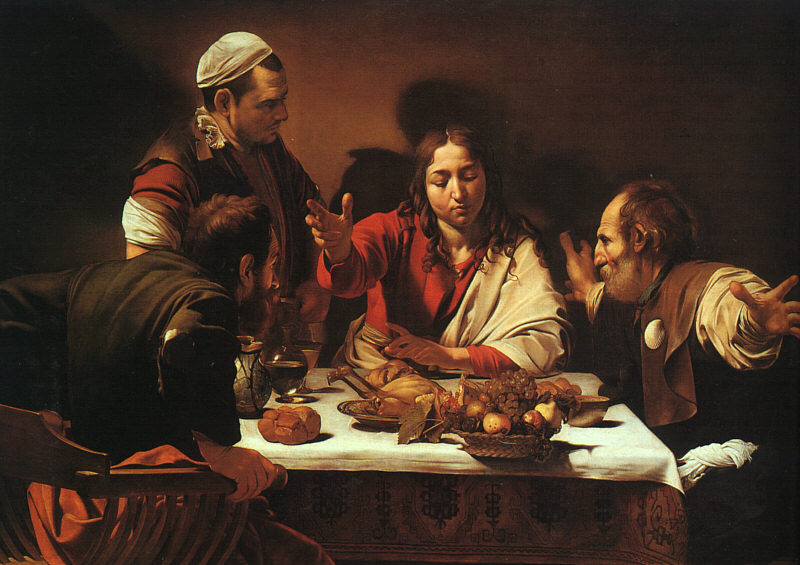
Caravaggio – The Road to Emmaus
Let’s just take a moment to look at the painting while I talk about it. It captures the very moment of realisation when Jesus blesses the bread and the two disciples recognise who he is – this is Christ who has been walking with them on their journey from Jerusalem. Their doubts are taken away and they know that Christ is risen.
I wonder where we are in the picture? Where are you? Just look at how Caravaggio has painted it; the position of the disciples; the figures and particularly their hands and arms form an incomplete circle. There is space at the table for us. And as our eyes are drawn to the inviting space at the table, we notice the bowl of fruit. We see that it is symbolic of the fruits of the Spirit and casting the shadow of a fish, the sign of the Christian believer, but also we notice that the bowl is hanging precariously off the table and we instinctively want to rush in and catch it! In the process of moving forward we receive the gifts of the spirit and find ourselves at the table with Christ, at one with the disciples in their realisation that this is the risen Lord, the one who is known to us in the breaking of the bread.
Spiritual Communion
I wasn’t exaggerating when I said looking at this painting was an experience of spiritual communion. For me it certainly was.
In the full copy of the Anglican Prayer book, the red one that the priests use, there is a note on p.693.
“If for good reason it is not possible for the sick person to receive the sacrament, the minister shall give assurance that all who repent of their sins, trust in Christ, and celebrate his saving work with grateful thanks, truly eat and drink the body and blood of Christ, even though the bread may not have been eaten or the wine drunk.”
Spiritual communion has been tended to be understood for administration of communion to individuals who are extremely sick, but not exclusively so. The Episcopal church of the USA makes provision for it in battlefield conditions. And the 1662 Book of Common prayer provides for it for “reasons of sickness” or “any other just impediment”.
A recent statement from Bishop Brad Billings in Melbourne during this COVID-19 lockdown said:
“This describes broadly the present circumstances in which we find ourselves both globally and in this nation. Most Anglicans are being prevented from physically receiving the sacrament by the current pandemic. Whether experiencing the sickness ourselves in a physical way, or not, we are certainly experiencing its ramifications, with a result that we are being impeded from receiving the Sacrament of Holy Communion.”
In this streamed service on Facebook we are invited to sit at the table. Just as I experienced spiritual communion in meditating upon the painting by Caravaggio, I believe we share it now in this service.
You are welcome at the welcome table, always. You may choose to have bread and wine or water at home joining in Christian love (Agape) or you may simply choose to commune by praying with this service as you watch.
The Lesson of Emmaus
But two things come from today’s gospel –
Christ is with us on our journey,
Christ is made known to us in the breaking of the bread.
I believe that happens whether we are together physically or linked electronically by necessity of pandemic. Today and every Sunday may you be drawn into communion with Christ. May you be drawn into that amazing realization that Christ is walking with us and that Christ is risen indeed. Alleluia!
